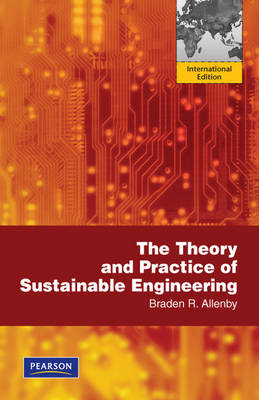
The Theory and Practice of Sustainable Engineering
Pearson Education (Verlag)
978-0-273-75216-5 (ISBN)
- Titel ist leider vergriffen;
keine Neuauflage - Artikel merken
Sustainable engineering is learning how to engineer responsibly and professionally in the Anthropocene: the Age of the Human. This textbook sketches out the cultural, social, institutional, and environmental context within which engineering and, more broadly, technology systems are now situated. It provides frameworks to facilitate understanding, communication, and the solving of highly complex problems with significant technological dimensions all in the name of generating more capable professionals competent in their chosen field, who are able to integrate other disciplines to address complex adaptive systems.
Chapter 1 So What Is Different Now? Or, Why We Need Sustainable Engineering
1.1. Introduction
1.2. Welcome to the Anthropocene
1.3 Evolution of the Anthropocene
1.4 The Fingerprint of the Anthropocene: Energy and Water
1.5 The Fingerprint of the Anthropocene: Human Imprints on Sinks and Material
Flows
1.6 Conclusion
Exercises
Annotated Bibliography
Chapter 2 Themes of the Anthropocene
2.1 Introduction
2.2 Globalization and Multiculturalism, Then and Now
2.3 Information and Communications Technology and Systems
2.4 Technology and Sustainability
2.5 Demographic Trends
Exercises
Annotated Bibliography
Chapter 3 Complexity
3.1 Complexity
3.2 Simple versus Complex Systems
3.3 Different Forms of Complexity
3.4 Understanding Complexity
3.5 Models, Ideology and Complexity
Exercises
Annotated Bibliography
Chapter 4 Sustainability
4.1 Introduction
4.2 Sustainable Development
4.3 Sustainability and Resources
4.4 From Sustainability to Sustainable Engineering
4.5 Sustainability and Global States
Exercises
Annotated Bibliography
Chapter 5 Homo Faber: Human History and Technology
5.1 Introduction
5.2 The Railroad as Technology System
5.3 Technology Clusters
Exercises
Annotated Bibliography
Chapter 6 Characteristics of Technology
6.1 Introduction
6.2 Product Design
6.3 Behavior of Technological Systems
6.4 The Three Levels of Technology Systems
6.5 Concluding Observations
Exercises
Annotated Bibliography
Chapter 7 Industrial Ecology
7.1 Introduction
7.2 Industrial Ecology
7.3 Life Cycle Assessment
7.4 Streamlined LCA
7.5 Systems Engineering
Exercises
Annotated Bibliography
Chapter 8 The Five Horsemen: Emerging Technologies
8.1 Introduction
8.2 The Five Horsemen
8.3 The Human as Design Space
Exercises
Annotated Bibliography
Chapter 9 Green Chemistry
9.1 Introduction
9.2 The Chlorofluorocarbon Case Study
9.3 Antimicrobials and Pharmaceuticals as Earth Systems
9.4 Policy Implications
Exercises
Annotated Bibliography
Chapter 10 Sustainable Engineering: Information and Communication Technology
10.1 Introduction
10.2 Framing ICT
10.3 Infrastructure Operations
10.4 Services
10.5 The Virtualization of Work, Digital Nomads, and the Triple Bottom Line
10.6 Virtualization of Work and the Evolution of Institutional Complexity
10.7 Conclusion
Exercises
Annotated Bibliography
Chapter 11 The Five Horsemen, Military Operations, and National Security
11.1 Introduction
11.2 Thinking about National Security
11.3 Concluding Thoughts
Exercises
Annotated Bibliography
Chapter 12 The Macroethics of Sustainable Engineering
12.1 Introduction
12.2 Framing Ethics
12.3 The Challenge of Macroethics
Exercises
Annotated Bibliography
Chapter 13 The Aral Sea, The Everglades, and Adaptive Management
13.1 Introduction: Adaptive Management
13.2 The Aral Sea
13.3 The Florida Everglades
13.4 Themes
13.5 Adaptive Management Principles
Exercises
Annotated Bibliography
Chapter 14 Earth Systems Engineering and Management: Sustainable Engineering at a Planetary Scale
14.1 Introduction
14.2 Geoengineering
14.3 Urban Design and Management, and High Modernism
14.4 Theoretical ESEM Principles
14.5 ESEM Governance Principles
14.6 ESEM Design and Management Principles
14.7 Sustainable Engineering, ESEM, and the Final Principle
Exercises
Annotated Bibliography
Chapter 15 The Engineer as Leader
15.1 Introduction
15.2 Attitude and Preparation
15.3 Lead by Following
15.4 Personal Characteristics
Exercises
Index of Boxes
Box 1.1: What is Sustainable Engineering?
Box 1.2: Exponentials
Box 1.3: Case Study: Corn-Based Ethanol
Box 1.4: Writing for your Audience
Box 2.1: Monsanto, Genetically Modified Organisms, and Corporate Responsibility
Box 2.2: Lessons of the Autonomic City for Sustainable Engineering
Box 3.1: Plug-in Automobiles and Bio-Fuel: Why Not to Fall in Love with a Technology
Box 4.1: The President's Council on Sustainable Development
Box 4.2: Reserves and Resources
Box 4.3: Toxicity, Hazard, and Risk
Box 5.1: Aspects of Technology
Box 5.2: Technological Determinism
Box 5.3: The Technological Trajectory of Money
Box 5.4: Perception and Technology
Box 6.1: Levels I and II, Revisited: The Shop Floor
Box 8.1: Transhumanism
Box 8.2: Who Defines the Playing Field? Conservation Biology and the Biodiversity Crisis
Box 8.3: Integrating the Brain with the Machine
Box 8.4: Using Metaphors and Analogies
Box 9.1: Principles of Green Chemistry
Box 9.2: Arsenic Management in the United States
Box 10.1: A Telecom Firm Perspective on Sustainable Engineering
Box 10.2: Design for Environment
Box 10.3: Scenarios and Scenario Planning
Box 10.4: ICT at the Bottom of the Pyramid
Box 11.1: Hard and Soft Power in the Modern World
Box 12.1: Respect and Reciprocity: The Golden Rule
Box 14.1: Mining as ESEM
| Erscheint lt. Verlag | 4.8.2011 |
|---|---|
| Sprache | englisch |
| Maße | 155 x 226 mm |
| Gewicht | 560 g |
| Themenwelt | Schulbuch / Wörterbuch |
| Naturwissenschaften ► Biologie ► Ökologie / Naturschutz | |
| Technik | |
| ISBN-10 | 0-273-75216-2 / 0273752162 |
| ISBN-13 | 978-0-273-75216-5 / 9780273752165 |
| Zustand | Neuware |
| Haben Sie eine Frage zum Produkt? |
aus dem Bereich


